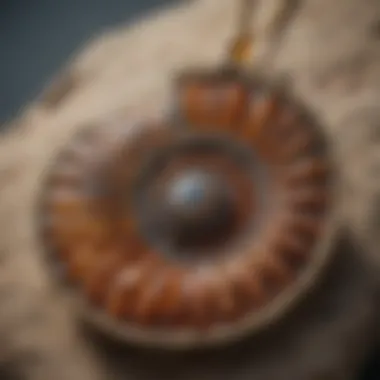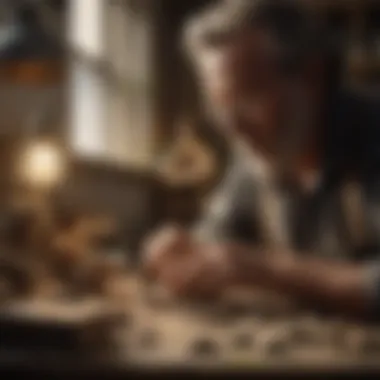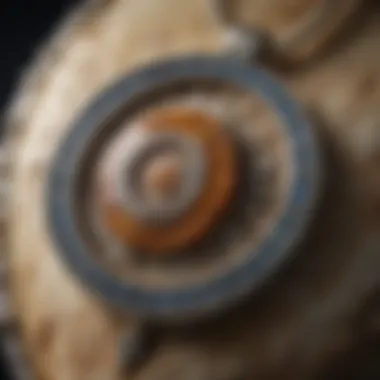Exploring Real Fossil Jewelry: A Comprehensive Guide


Intro
Fossil jewelry offers a unique intersection between geology and craftsmanship. The allure of owning a piece of earth's history is undeniable. Many collectors appreciate not just the aesthetic value of these articles, but also the stories they tell about life on Earth millions of years ago. As we navigate through the complexities of fossil jewelry, we will uncover the intricacies of fossil formation, discuss the materials typically used in jewelry-making, and explore the ethical dimensions surrounding fossil sourcing.
Rock and Fossil Identification
Identifying rocks and fossils is a critical skill for anyone interested in fossil jewelry. This allows collectors to make informed decisions when purchasing or trading pieces.
Types of Rocks and Fossils
There are myriad types of rocks and fossils available in the market. Common types of fossil materials used in jewelry include:
- Amber: A tree resin that often contains ancient insects trapped within.
- Jet: A fossilized wood that has been naturally compressed over time.
- Coral: Particularly precious coral, which has a deep red or pink color.
- Fossilized shells: These tell us a lot about the marine environments of the past.
Understanding these types helps in determining the quality and authenticity of a piece.
Characteristics to Look For
When identifying fossils, you should pay close attention to specific characteristics:
- Color: Fossils may display rich, varied colors.
- Patterns: Natural patterns can indicate age and differentiate them from synthetics.
- Weight: Authentic specimens often feel heavier than their fake counterparts.
Tools for Identification
Several tools can aid in rock and fossil identification.
- Hand lens: Useful for inspecting details closely.
- Geological hammer: Helps in breaking apart rock layers without damaging the fossil.
- Field guide: A book or mobile app dedicated to fossils can be invaluable for reference.
"Identifying the right fossil materials can enhance the value and story behind each piece of jewelry."
Collecting Tips and Techniques
For collectors, gathering fossils requires a methodical approach.
Best Practices for Collecting
Engaging in collection should be done responsibly. Always:
- Respect local laws about collection.
- Obtain permission if collecting on private property.
- Avoid taking from protected lands.
Locating Prime Collecting Sites
Finding the right place to collect fossils is critical. Some locations you might consider include:
- Riverbanks
- Road cuts
- Natural erosion areas
- Coastal cliffs
Networking with other collectors can lead to fruitful collecting expeditions.
How to Safely Extract Specimens
When it comes to extraction, safety is paramount. Always:
- Use proper equipment to minimize damage to fossils.
- Wear protective gloves and goggles.
- Be patient; rushing can lead to broken or damaged specimens.
Preservation and Display
Once you have collected fossils, preserving them correctly is key to maintaining their integrity.
Techniques for Preserving Rocks and Fossils
Fossils can degrade if not stored properly. Consider:
- Storing in cool, dry places: Humidity can weaken fossils.
- Using acid-free materials: This ensures protection without causing damage.
Proper Storage Methods
For the best preservation, you might use:
- Acid-free cases: For delicate pieces.
- Microclimate boxes: They provide a controlled environment.
Creative Display Ideas
To showcase your fossil jewelry:


- Use shadow boxes to highlight individual pieces.
- Create themed displays based on type or color.
- Use natural materials like driftwood for a cohesive look.
Geological Insights
Understanding the geological background enriches appreciation for fossil jewelry.
Geological Formations and Processes
The ages of fossils can range dramatically. Familiarizing yourself with various geological periods enhances the story behind each fossil.
Historical Significance of Rocks and Fossils
Many fossils reveal information about ancient ecosystems and climate changes. Recognizing this context deepens admiration and awareness.
Notable Discoveries in the Field
Check resources like Wikipedia and Britannica for significant discoveries. They offer insights that can boost both knowledge and storytelling when sharing your fossil jewelry.
Prologue to Real Fossil Jewelry
Fossil jewelry stands as a unique intersection of nature and human creativity. It combines centuries-old natural history with artistic expression. Understanding real fossil jewelry provides insight into the cultural significance and the craftsmanship involved. This exploration reveals why these pieces are not just accessories, but treasures that tell stories of the Earth's history.
Defining Real Fossil Jewelry
Real fossil jewelry refers to adornments crafted using actual fossils derived from natural materials, like amber or marine fossils. Each piece serves as a tangible link to the past. Unlike synthetic counterparts, these items offer authenticity and originality. This authenticity appeals to collectors and enthusiasts who value the connection between history and art.
Key Points:
- Material authenticity: Only utilizes genuine fossil materials.
- Cultural significance: Reflects historical narratives.
- Connection to nature: Represents the Earth’s geological timeline.
The Intersection of Nature and Art
Fossil jewelry exemplifies how nature and art can intertwine. Artisans take raw materials, shaped over millions of years by natural processes, and transform them into wearable art. This craftsmanship involves meticulous design and careful selection of pieces that accentuate the fossil's unique characteristics. Each creation offers a glimpse into the environment from which it originated, creating a dialogue between the past and present.
This blending of artistic intent with natural form not only enhances the visual appeal of the jewelry but also elevates its meaning. It allows wearers to appreciate the beauty of fossils while actively participating in the preservation aspect of history.
"Fossil jewelry encapsulates moments in time, transforming them into something both beautiful and meaningful."
Aspects of this Intersection:
- Artistic techniques: Various methods are used in designing fossil jewelry, including polishing, carving, or embedding fossils in metals.
- Environmental reflection: The design often mirrors the ecosystem and the historical context of the fossil.
- Personal expression: Wearers carry a story about nature and history.
By exploring real fossil jewelry, individuals not only acquire unique pieces but also engage with a rich tapestry of Earth's history and artistic endeavor.
Understanding Fossils
The concept of fossils is integral to comprehending the allure of fossil jewelry. Fossils are natural relics, remnants of organisms from epochs long gone. They encapsulate history and biology, making them not just decorative but also educational artifacts. Fossils speak volumes about the Earth's past, showcasing the diversity of life and the processes that shaped our planet. Understanding how fossils form and the types used in jewelry helps collectors appreciate their value far beyond mere aesthetics.
How Fossils Form
Fossilization is a complex process that occurs over millions of years. It typically begins when an organism dies and is buried by sediment. Over time, minerals from the surrounding materials seep into the remains, gradually replacing the organic matter. This transformation can result in a durable fossil. Factors such as the environment, pressure, and time play significant roles in this process. Knowing this helps collectors assess the age and significance of fossils within their jewelry.
Types of Fossils Used in Jewelry
Fossils in jewelry are varied, with each type offering unique characteristics and beauty. They are cherished not only for their appearance but also for their origins and stories.
Amber
Amber is fossilized tree resin, recognized for its warm, rich colors and ability to preserve inclusions like insects or plants. It is lightweight and easy to carve, making it a favored material in jewelry. The
good aspect of amber is its aesthetic appeal, as it glows warmly in light. However, its susceptibility to scratches means careful handling is crucial.
Copal
Copal is similar to amber but is not fully fossilized. It is often younger than amber, typically between a few thousand to a few million years old. Its resinous quality retains a natural luster, making it attractive for jewelry. While it lacks the deep color depth of aged amber, copal's transparency offers a unique charm. Its primary disadvantage is that it can be less durable, making it essential to handle with care.
Marine Fossils
Marine fossils such as shells or corals are popular choices in jewelry-making. They carry a story of aquatic life and often feature intricate designs. These fossils are usually robust and can achieve exquisite polishing. However, their beauty can vary significantly based on species and conditions, which may affect their perceived value. Collectors often appreciate their connection to the ocean and the sense of timeless elegance they convey.
Plant Fossils
Plant fossils often exhibit stunning details of ancient flora. They can include imprints of leaves or whole plants that capture the essence of prehistoric ecosystems. These fossils are distinctly different from animal remains, showcasing nature's beauty in a unique form. Their main advantage lies in their intricate artistry, which can enhance any jewelry piece. Nevertheless, their rarity can make them more costly, a consideration for collectors looking to invest in unique specimens.
"Fossils are the records of life before us; each piece in jewelry is a fragment of our planet's extensive story."


Understanding the types of fossils and their characteristics provides collectors a deeper insight into their jewelry. It goes beyond beauty, offering a connection to the natural history that shaped our world.
History of Fossil Jewelry
The history of fossil jewelry is both intricate and compelling. It intertwines natural history with human creativity. Understanding this history provides insights into how these pieces serve not just as adornments but as artifacts that tell stories of our past. From ancient civilizations to modern consumers, fossil jewelry exhibits a unique blend of cultural significance and artistic expression that has evolved over thousands of years.
Cultural Significance of Fossils
Fossils have long held a place in various cultures. They are often seen as symbols of ancient life, reminding humanity of its connection to the Earth. In many societies, fossils were revered and integrated into spiritual practices. For example, many indigenous cultures viewed fossils, particularly ammonites, as sacred objects that represented transformation and eternal life.
In addition to their spiritual significance, fossils also embody the passage of time. They can carry meanings tied to the geological past, thus serving as conversation starters in social gatherings. Fossil jewelry becomes a vessel of stories, transcending generations and connecting people to their ancestry. This affinity for fossils enables collectors to appreciate the deep ties between geology and culture.
Historical Use in Jewelry
The use of fossils in jewelry is a tradition that dates back to ancient times. Early humans adorned themselves with naturally occurring items from their surroundings, including fossilized materials. For example, ancient Egyptians used copal and amber, incorporating these materials into their decorative arts. The beauty and rarity of these items made them desirable for crafting jewelry.
As societies advanced, so did the techniques employed to create fossil jewelry. During the Renaissance, fossil materials gained popularity among artists and jewelers. The intricate carving and setting of fossils into brooches and pendants became a mark of sophistication and style. This period saw a surge in the appreciation of natural history and aesthetics, culminating in fossil jewelry becoming a status symbol among the elite.
In modern times, fossil jewelry has evolved alongside technological advancements. The introduction of laser cutting and electroforming techniques has made it easier to incorporate fossils into contemporary designs. Today, various fossil types, such as amber and plant fossils, are often featured in unique and creative pieces. Collectors of fossil jewelry come from diverse backgrounds, seeking both artistic beauty and a tangible link to Earth’s history.
Understanding the historical context of fossils in jewelry offers insights into contemporary design, showcasing the timeless appeal of these natural treasures.
The evolving styles and uses of fossil jewelry reflect broader societal changes, highlighting its relevance in today’s market. Collectors appreciate these pieces not only for their beauty but also for the histories they represent, making fossil jewelry a remarkable intersection of art, culture, and natural history.
Craftsmanship of Fossil Jewelry
The craftsmanship of fossil jewelry is crucial for several reasons. First, it blends nature and creativity in a unique way. Artisans carefully select fossils that showcase distinct characteristics. Each piece tells a story, allowing collectors to connect with the natural world. Craftsmanship goes beyond just assembling materials. It involves thoughtful design and artistry that highlight the beauty of fossils.
Techniques in Jewelry Design
The techniques used in jewelry design involve many steps. These steps require precision and care to ensure high quality. Artisans often begin with the selection of the fossil. They consider factors such as color, texture, and preservation quality. Once a suitable fossil is found, the next phase involves cutting and polishing. Tools like diamond wheels and lapidary equipment are commonly used for this. This process demands skill to enhance the fossil without damaging it.
In addition to cutting, some pieces require setting techniques. Common methods include bezel setting and prong setting. Bezel setting surrounds the fossil with a metal frame. This protects the fossil while showcasing its features. Prong settings hold the fossil in place with small metal claws. Each technique impacts the overall aesthetic and security of the jewelry piece.
"A well-crafted piece of fossil jewelry can serve as both an accessory and an art piece."
Combining Fossils with Metals
Combining fossils with metals is an art in itself. Various metals can complement the organic nature of fossils. Popular choices include sterling silver, gold, and bronze. Each metal presents different visual appeal and durability.
Artisans consider the harmony between the fossil and the metal chosen. This balance is key to achieving a cohesive design. For example, warm-toned metals pair well with amber, enhancing its natural glow. Cold-toned metals, like silver, can bring out the patterns in plant fossils.
The joining process often involves soldering or adhesive methods. Soldering provides a strong bond, necessary for pieces worn regularly. Whereas, adhesives might be used for more delicate designs. Regardless of the method, ensuring durability without compromising aesthetics is vital.
Ethics in Sourcing Fossils
Sourcing fossils for jewelry raises significant ethical questions. The practices involved in acquiring these materials can impact the environment, the scientific record, and the communities involved in the supply chain. Therefore, it is crucial to address ethics carefully. Understanding these elements enhances appreciation for the jewelry and its journey from nature to adornment.
Legal Considerations
Legal considerations in fossil sourcing involve understanding local and international laws. Many countries regulate the collection and trade of fossils to protect their geological heritage. In the United States, for instance, the Fossil Resources Protection Act governs the collection of fossils on federal lands. Collectors must ensure they possess the necessary permits for legally collecting fossils. Moreover, it's illegal to collect fossils from protected sites or private lands without permission.
Furthermore, importing fossils across international borders can also raise legal issues. The Convention on International Trade in Endangered Species of Wild Fauna and Flora (CITES) restricts the trade of certain fossil specimens that are considered endangered species. Thus, buyers should be diligent in verifying the documentation of their fossil acquisitions.
Sustainability Practices
Sustainability practices in sourcing fossils focus on maintaining ecological balance and ensuring responsible use of natural resources. Collectors should seek to buy fossils from reputable suppliers committed to sustainable practices. This can include adopting methods that minimize damage to ecosystems during collection and transportation.
Some artisans and suppliers actively promote sustainability by:
- Utilizing reclaimed materials, which helps reduce pressure on fossil sites.
- Supporting local communities by purchasing fossils directly from their sources. This approach fosters economies and reduces exploitative practices.
- Engaging in educational efforts to inform collectors about the implications of fossil sourcing.
Collectors can encourage sustainability by choosing jewelry made from sustainably sourced fossils. This practice not only helps preserve fossil resources but also honors the history embedded within those pieces.
By prioritizing legal and sustainable sourcing practices, collectors can enjoy their fossil jewelry with respect for both its natural origin and ethical implications.
Market Trends in Fossil Jewelry
The market for fossil jewelry is growing and evolving, reflecting wider trends in both consumer interest and environmental awareness. As more people seek unique pieces that combine artistry with history, fossil jewelry has carved a niche in the broader jewelry market. Recognizing the nuances in consumer preferences, designers and retailers are adapting their offerings to match. The significance of current market trends lies in how they influence the demand for specific types of fossil jewelry and the pricing strategies that emerge in response.
Current Demand and Popularity
Currently, the demand for fossil jewelry has reached a notable high. This can be attributed to several factors:
- Collectibility: Fossils carry inherent value and story, making them attractive to collectors.
- Aesthetics: The unique shapes, colors, and textures found in fossil materials appeal to those looking for distinctive jewelry pieces. For instance, amber's warm hues and unique inclusions resonate with consumers who appreciate natural beauty.
- Sustainability Link: As eco-consciousness rises, fossil jewelry provides an alternative to traditional materials, allowing consumers to express their values through their purchases. Fossils are finite resources, and buying fossil jewelry can be perceived as a step toward sustainable choices.


Reputable retailers have noticed this surge and are adjusting their collections to feature more fossil-based items. Social media has played a critical role in amplifying these trends, with visual platforms showcasing stunning pieces that capture attention and spark interest in fossil jewelry among potential buyers.
Pricing and Value Assessment
Assessing the price and value of fossil jewelry involves multiple factors that reflect its unique characteristics. The following elements are crucial:
- Rarity of Fossil Types: Certain fossils, like high-quality amber, can command premium prices due to their scarcity.
- Craftsmanship: The skill level involved in creating each piece affects its market value. Handcrafted items often sell for higher prices.
- Cultural Significance: Pieces with historical or cultural relevance may also fetch higher values, reflecting their intrinsic narrative value.
When determining the price of fossil jewelry, consumers should consider:
- The authenticity of the fossil and certification of its source.
- Comparisons with similar items in the market to gauge a fair price.
- Overall design and its appeal to targeted demographics.
Understanding these pricing dynamics is essential for both collectors and casual consumers, as it ensures informed purchasing decisions.
As the market evolves, it will continue to reflect changing consumer behavior and preferences, which in turn may influence production methods and ethical sourcing practices. Following these trends is important for any collector or enthusiast engaged with the world of fossil jewelry.
Fossil Jewelry in Modern Fashion
Fossil jewelry has emerged as a distinct segment in the fashion landscape. This unique format emphasizes not just aesthetic value, but also the connection to natural history. As more consumers seek out items with a story and significance, fossil jewelry fits perfectly. Its appeal is not merely in the beauty but in its deeper narrative, linking the wearer to ecosystems and eras long past.
Integration into Contemporary Styles
The fusion of fossil jewelry into contemporary styles reflects a broader trend of incorporating natural elements in fashion. Designers today often aim for a balanced approach, blending sophistication with organic textures. Fossil elements like amber and marine fossils can be seamlessly integrated into modern minimalist designs or bold statement pieces, making them versatile for various occasions.
Using fossils in jewelry is not limited to just standard forms such as pendants or rings; designers now explore innovative applications, such as:
- Layered necklaces that combine fossils with other materials.
- Unique earrings that showcase intricate fossil patterns.
- Bracelets incorporating mixed media, enhancing tactile experience.
These approaches prove that fossil jewelry is adaptable and can align with various fashion philosophies, from bohemian to urban chic.
Influence of Social Media
Social media plays a pivotal role in promoting fossil jewelry. Platforms like Instagram and Pinterest fuel interest through visual aesthetics. Influencers and designers share their collections, often showcasing the stories behind each piece. This not only drives sales but also cultivates a community of enthusiasts who appreciate the craftsmanship involved.
Engagement on social media highlights several key aspects:
- Authenticity: Buyers are drawn to the genuine history of fossils, linking them more closely with their origins.
- Trends: Social media can accelerate trends, impacting what types of fossil jewelry gain popularity.
- Community Building: Many collectors and enthusiasts share experiences, furthering their knowledge and appreciation for fossil jewelry.
The blend of natural history and modern design resonates deeply in today’s fashion world, making fossil jewelry a sought-after accessory.
Overall, fossil jewelry occupies a unique and important space in modern fashion. It offers both aesthetic beauty and a connection to history, encouraging wearers to embrace pieces that are as much about personal style as they are about the stories they tell.
Caring for Fossil Jewelry
Caring for fossil jewelry is essential not just for aesthetic reasons, but also for preserving the historical and scientific value of these unique pieces. Fossil jewelry often incorporates ancient biological material, which makes it different from traditional jewelry. Adopting the correct care techniques can extend the lifetime of these items and maintain their beauty.
Cleaning Techniques
Cleaning fossil jewelry requires a gentle touch. Fossils can be delicate and may be damaged by harsh chemicals or abrasive materials. Here are some recommended cleaning techniques:
- Use warm soapy water: A mild soap, such as dish soap, can be mixed with warm water. Using a soft cloth, gently wipe the surface of the jewelry. Avoid scrubbing hard.
- Avoid chemicals: Many commercial jewelry cleaners contain strong chemicals that can harm fossils. Always read labels and avoid any product that does not specify it is safe for natural materials.
- Soft brushes: Sometimes, a soft-bristled brush can help remove dirt lodged in small crevices. Use an old toothbrush or a makeup brush that you no longer use.
It’s important to dry the jewelry carefully after cleaning, as moisture can cause deterioration. Pat it dry gently with a soft cloth to avoid scratches.
Storage Solutions
Storing fossil jewelry properly is critical. Improper storage can lead to scratches, chipping, or even breaking. Here are some smart storage solutions:
- Individual pouches: Store each piece of jewelry in a soft pouch made of cloth. This can limit movement and prevent scratches.
- Avoid direct sunlight: Store away from sunlight to avoid fading and degradation of materials.
- Use padded storage boxes: Consider a padded jewelry box that provides cushioning to prevent impact damage.
- Keep away from humidity: Fossil materials might be sensitive to extreme humidity, so consider a dry place for storage. A silica gel packet in the storage area can help absorb moisture.
Caring for fossil jewelry, through proper cleaning and storage, not only prolongs its life but also enhances its intrinsic value. This diligent attention can resonate with both personal and collectible significance.
End
Exploring the realm of real fossil jewelry opens a window into a fascinating intersection of nature and artistry. This section emphasizes the importance of appreciating the unique attributes of fossil jewelry, not only as decorative items but as historical relics that tell stories of our planet's past. Fossil jewelry represents more than mere adornment; it encapsulates millions of years of geological processes, information about ancient ecosystems, and the dynamics of life that once thrived.
Appreciating Fossil Jewelry
To truly appreciate fossil jewelry, one must acknowledge the intrinsic value of the materials used. Fossils are not simply remnants of the past; they embody scientific curiosity and artistic exploration. Collectors and enthusiasts should recognize that each piece carries a narrative that reflects its formation, age, and the environment from which it originated.
When wearing fossil jewelry, one not only enhances personal style but also fosters a connection to the Earth’s history. The beauty found in pieces like amber or marine fossils is a testament to the craftsmanship involved in their transformation from natural formations into wearable art. Beyond aesthetics, these pieces invite discussion and promote awareness about paleontology and conservation.
Moreover, the craftsmanship involved in creating fossil jewelry deserves recognition. Artisans employ various techniques to ensure the beauty and integrity of the fossils are preserved. The blend of natural material with metals also signifies a deeper relationship between nature and human ingenuity, making fossil jewelry a remarkable field for collectors and aficionados.
Future of Fossil Jewelry
Looking forward, the future of fossil jewelry appears promising yet complex. As consumer awareness around ethical sourcing grows, it becomes crucial for artisans and retailers to prioritize responsible practices. This not only sustains the market but also protects the environment and historical sites where these fossils are found.
The integration of sustainability into fossil jewelry is becoming a necessary consideration. Both artisans and collectors are increasingly inclined toward sustainable practices that respect the origins of fossil materials. By supporting businesses that prioritize ethical sourcing, consumers contribute to preserving the natural beauty and geological history these fossils represent.
Additionally, technological advancements in preservation methods and design techniques will likely enhance the attractiveness and durability of fossil jewelry. Innovations in how fossils are displayed and combined with other materials can lead to unique creations that captivate modern audiences. As the trend continues, we may see an increase in collaboration between scientists, artists, and jewelers, fostering a deeper appreciation and understanding of fossil jewelry.







